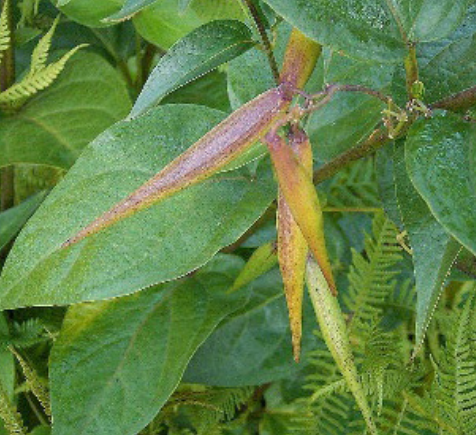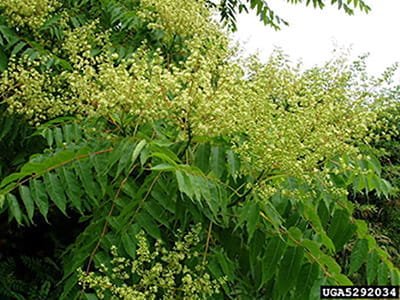
Invasive Species
WHAT ARE INVASIVE SPECIES?
Invasive species are non-native species (species not naturally found in an area, and were introduced through human activities) that cause harm to humans, the environment, or the economy. It is important to know that not all non-native species are invasive, and must cause harm to be considered invasive. Invasive species can be transported by boats, fishing equipment, and by accidental release. Invasive species can spread to freshwater sources via stormwater too, by seedlings that get caught up in flood events.
WHO MANAGES INVASIVES?
In Michigan, they are called Cooperative Invasive Species Management Areas, or CISMAs. Visit lakestclaircisma.com for Macomb County, and oaklandinvasivespecies.org for Oakland County. To learn more about what to do when you find an invasive species, scan the QR code to the right of this text box. Below are some (but not all!) invasive species to keep a lookout for.
Aquatic Plants
COMMON INVASIVE & NUISANCE SPECIES
-

DIDYMO "ROCK SNOT"
Didymosphenia geminata
Known for its brown, tan, or yellow appearance with a cotton-like texture, Didymo can often be mistaken for fiberglass or toilet paper. This invasive species thrives in clear, shallow, cold, and nutrient-poor waters, commonly found in freshwater rivers, streams, and lakes.
-

EUROPEAN FROG-BIT
Hydrocharis morsus-ranae
This aquatic plant creates dense floating mats, resembling miniature water lilies, and features white three-petaled flowers with yellow bases. It's commonly sighted in standing or slow-moving water bodies, wetlands, lakes, and canals.
-

WATER HYACINTH
Eichhornia crassipes
This species is a free-floating aquatic plant with thick, glossy leaves and lavender to violet flowers. It forms dense mats on the water's surface, impeding water flow and hindering sunlight penetration, which can disrupt native aquatic ecosystems. Rapid reproduction via stolons and seeds contributes to its invasive nature, often causing clogging in waterways, lakes, and ponds.
-

WATER LETTUCE
Pistia stratiotes
As a free-floating aquatic plant, water lettuce forms rosettes with feathery roots extending up to 80cm below the water's surface. Its leaves, thick and ridged, boast a dull light green color with short velvety hairs. It predominantly resides in ponds, lakes, ditches, and slow-moving or still water.
Terrestrial Plants & Shrubs
COMMON INVASIVE & NUISANCE SPECIES
-

BLACK JETBEAD
Rhodotypos scandens
Resembling raspberry leaflets, the bright green leaves of the Black Jetbead feature serrated edges. It blooms white, four-petaled flowers, forming black, hard, ovoid fruits. Caution is advised as the entire plant is toxic. It tends to thrive in sunny, dry, well-drained sites, shade, and even harsh urban conditions.
-

BLACK SWOLLOW-WORT
Cynanchum louiseae
Black Swallow-wort, scientifically known as Cynanchum louiseae, is a perennial vine that can grow up to 6 feet in height. This invasive species produces dark, narrow leaves and small, dark purple to black flowers. Its distinctive pods split open to release seeds with silky hairs, aiding in wind dispersal. It invades a variety of habitats, including forests, fields, and disturbed areas, outcompeting native vegetation.
-

GLOSSY BUCKTHORN
Frangula alnus
Glossy Buckthorn, scientifically known as Frangula alnus, is a deciduous shrub or small tree with dark, glossy leaves and clusters of small black fruits. Invasive in nature, it forms dense thickets in wetlands, woodlands, and along waterways, outcompeting native vegetation. Its aggressive growth and ability to alter soil conditions negatively impact the ecosystems by reducing biodiversity and disrupting natural habitats.
-

JAPANESE KNOTWEED
Fallopia japonica / Polygonum cuspidatum
This robust, perennial plant with bamboo-like stems and heart-shaped leaves forms dense thickets, crowding out native vegetation and disrupting natural ecosystems. Its aggressive growth and ability to spread through rhizomes make it challenging to eradicate. The plant's rapid colonization along riverbanks, roadsides, and disturbed areas poses a serious threat to local biodiversity and infrastructure.
-
MULTIFLORA ROSE
Rosa multiflora
The multiflora rose, a multi-stemmed shrub reaching heights of up to 15 feet, boasts divided leaves with sharply toothed leaflets. It produces clusters of fragrant, white to pink flowers followed by small, bright-red rose hips that persist through the winter. Thriving in various environments, it's found in pastures, old fields, roadsides, forests, and wetlands.
-
PHRAGMITES
Phragmites australis
Phragmites stands between 6 to 13 feet tall, and forms dense patches typically found near water bodies, often resembling cattails. Identified by a tassel atop the stem, they thrive in diverse habitats, including riverbanks, ditches, wetlands, and occasionally upland areas.
-

PURPLE LOOSESTRIFE
Lythrum salicaria
Purple Loosestrife is a tall perennial herb with spikes of magenta-purple flowers. Thriving in wetlands and moist soil, it forms dense stands that outcompete native plants, reducing biodiversity and altering ecosystems. Its ability to produce abundant seeds and spread rapidly allows it to colonize various habitats, including marshes, riverbanks, and roadside ditches, posing a significant threat to wetland ecosystems.
-

TREE OF HEAVEN
Ailanthus altissima
The Tree of Heaven is a fast-growing deciduous tree with large, pinnately compound leaves and a distinctive, unpleasant odor. Recognized for its adaptability to diverse environments, this invasive species spreads rapidly, often outcompeting native plants. Commonly found in urban areas, along roadsides, and in disturbed habitats, it can form dense thickets, impacting native biodiversity and disrupting ecosystems.
Animals
COMMON INVASIVE & NUISANCE SPECIES
-

NEW ZEALAND MUDSNAIL
Potamopyrgus antipodarum
These small snails, about 1/8 inches long and light brown to black in color, have a distinctive right-handed shell with 5-6 whorls. They typically congregate in high densities on substrates of rivers/streams, under woody debris/detritus, and thrive in cold water, providing no nutritional value to fish.
-

RED SWAMP CRAYFISH
Procambarus clarkii
Distinguished by its dark coloration and raised red bumps on claws, the Red Swamp Crayfish exhibits an elongated head with a triangular rostrum. These aggressive miniature lobster-like creatures inhabit freshwater habitats, burrows, and river/stream bottoms, and are even capable of traveling over land.
-

SPOTTED LANTERNFLY
Lycorma delicatula
The Spotted Lanternfly, scientifically named Lycorma delicatula, is an invasive planthopper known for its colorful wings with distinct spots. Originating from Asia, it poses a significant threat to various plants, particularly fruit trees, grapevines, and hardwoods. Its feeding habits damage plant tissues, weakening and sometimes killing the host plants. As it spreads quickly, it threatens agriculture and forest ecosystems, prompting significant concern for pest control and management efforts.
WHAT YOU CAN DO TO HELP STOP THE SPREAD OF INVASIVE SPECIES:
Report sighting to the Michigan Invasive Species Information Network (MISIN)
Clean and decontaminate recreational equipment (Kayaks, boats, trailers, waders, etc)
Plant native species in gardens and promote native plant conservation
Learn more about invasives and other environmental concerns
Participate in an invasive species removal with CRWC.
Never release any plant or animals into the wild
Photos of European Frog-bit, Asian Bittersweet, Japanese Knotweed, Water Hyacinth, Black Swollow-wort, and water lettuce from the State of Michigan.



